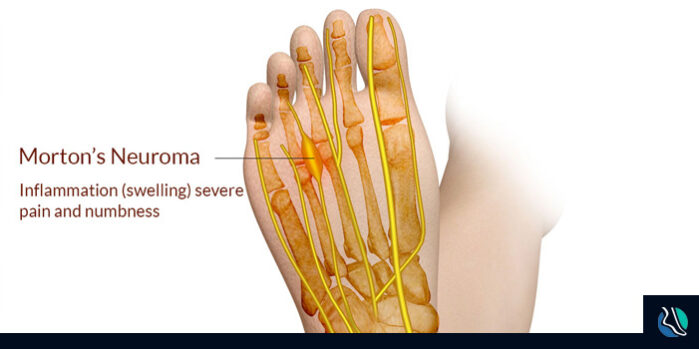What Is Neuroma?
Neuroma by definition is the thickening and inflammation of a nerve. The most common Neuroma occurring in the foot is the Morton’s Neuroma. Morton’s Neuroma most commonly occurs between the 3rd and 4th toes of the foot. The second most common location is between the 2nd and 3rd toes. This condition is caused by local trauma to the nerve by the adjacent bones and ligaments. The nerve becomes thickened and irritated. The cause is usually tight fitting shoes, high heels or any shoe that causes the toes to get pushed together.
Symptoms
The thickening of the nerve usually causes the affected toes to cramp or become numb. Patients usually reports the need to “rub the toes” to relieve the pain. Pain usually occurs after periods of walking and can become more frequent if untreated. Occasionally there may be a sensation of a sock being bunched up under the foot, a marble in the shoe or a “clicking” sensation between the toes.
Diagnosis
When you come to the office, your Podiatrist will perform a thorough history and examine your foot. This problem can usually be diagnosed in the office without any other testing. On occasion, x-ray, ultra sound or MRI may be used to aid in the proper diagnosis. During the examination of your foot your Podiatrist will check for the presence of a “clicking” which can be felt between the bones in your foot. This is a sure sign of a Morton’s Neuroma.
Treatment
Initial treatment usually involves:
- Anti-inflammatory medication;
- Injection of a corticosteroid medication or alcohol sclerosing medication, which will shrink the size of the nerve;
- Orthotics (custom molded arch support) which will correct any biomechanical imbalances which may contribute to this problem;
- If the above treatments fail to relieve the pain, there is a minimally invasive procedure known as Radio-frequency Lesioning which does not involve cutting of skin or tissue; and
- If all conservative measures fail, your Podiatrist will discuss surgical removal of the affected nerve.
973-927-2525 – Call our office if:
- You experience numbness or tingling of your toes;
- You experience cramping of your toes;
- You have discomfort in several types of shoes; and
- You have a burning or “stabbing” pain in or behind your toes.
How Useful Was The Information On This Page
[rating_form id=”1″]







